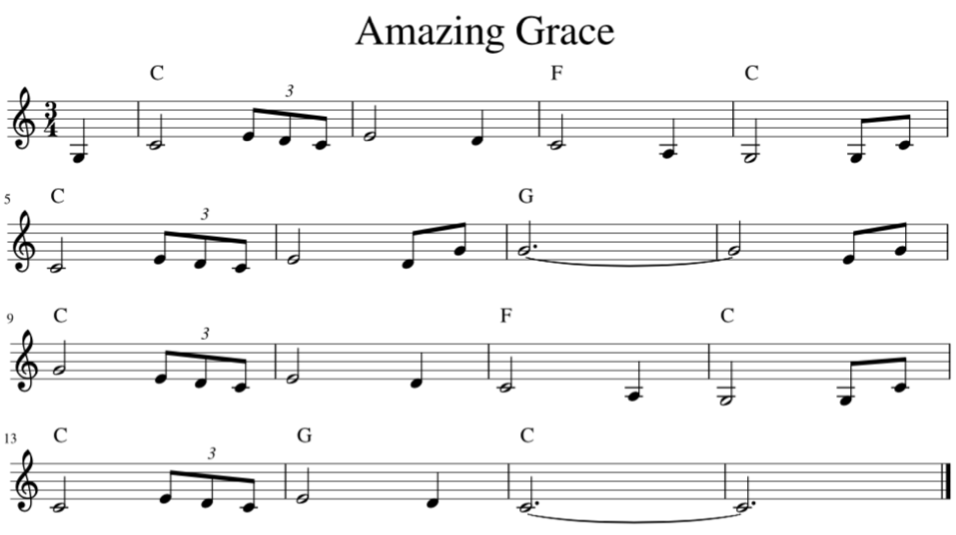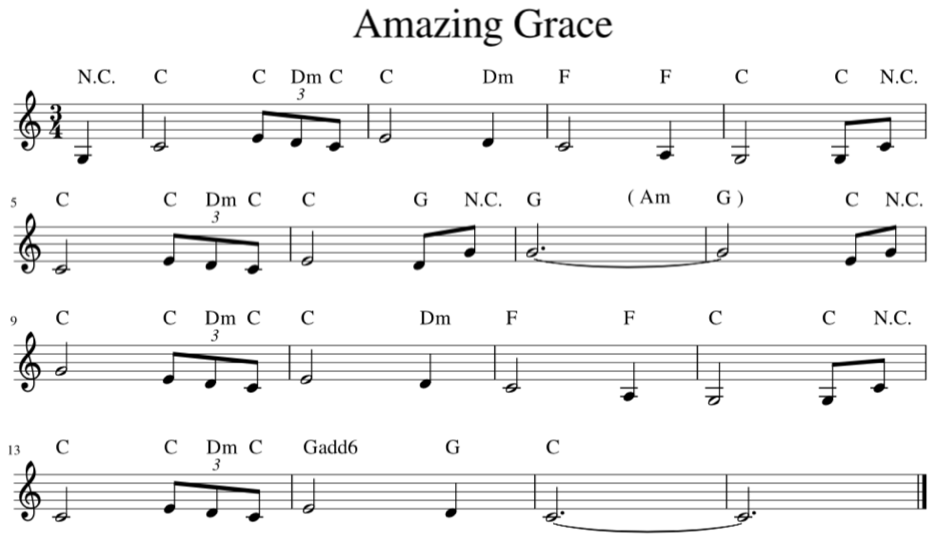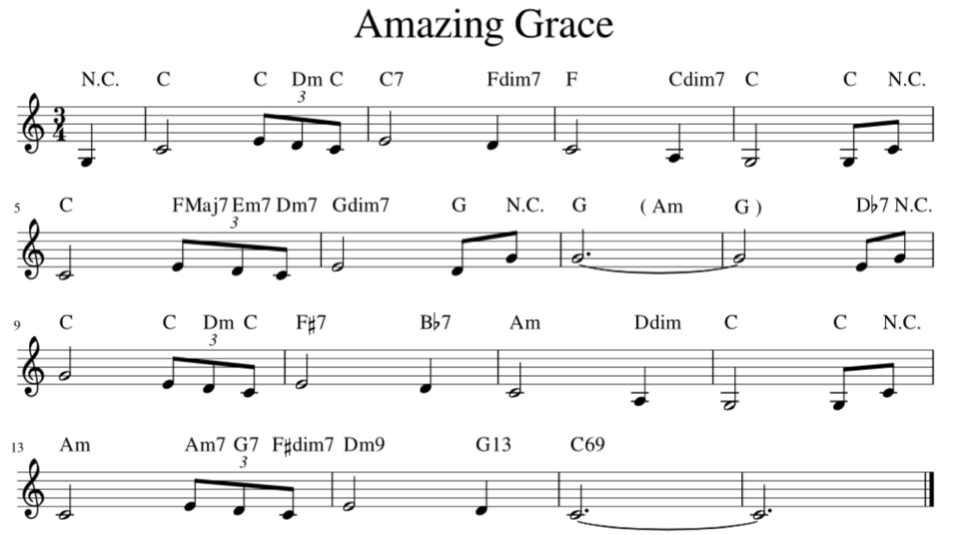Gospel has had an influence on Jazz. Many Jazz pianists started off playing Gospel piano at church before transitioning to Jazz (for example, John Hicks). And naturally they brought many Gospel piano techniques to their Jazz playing. So in this lesson we will discuss a few of these techniques and apply them to rehamonize the song Amazing Grace.
First, let’s see the basic version, in the key of C for convenience.

As you can see, it has a nice simple chord progression – only using the I, IV, and V chords. Now, to make this sound a bit more ‘Gospel-like’ we are going to do a number of things
- We are going to harmonise (almost) every single melody note with a chord. We will be using 3 or 4 note chords (so triads or 7ths chords). And we are going to pick appropriate chords and inversions such that we always have the melody note on top.
- We will be playing all the chords in close position – such that all the notes are within an octave range.
- The chords are going to mostly use parallel motion to move from chord to chord. That is, we are going to be moving all the notes of the chord (or the ‘voices’) up or down together. We won’t have some voices moving up and some moving down. We want all the voices to move in the same direction.
- We will be using passing chords to harmonise the melody. Spcifically, we will be using something called a:
- ‘Couple’ (or an upper neighbour chord) – to harmonise the song. Now, a ‘couple’ are two chords that are next to each other. They are neighbouring chords. For example, in the key of C Major the chords C and Dm are a couple; and the chords G and Am are a couple – right, because they are neighbours, they are next to each other. When playing the melody we will try alternating between these couple chords. So if we have a C chord, we will be moving between C and Dm to play the melody (as it fits the melody). If we have a G chord, we will be moving between G and Am. A couple chord, however, does NOT have to be in the diatonic key. The chords C & Ddim are also couple chords. Indeed, you could even have chromatic couple chords (like C & Dbm) if the melody required it. But couple chords tend to sound better when the higher chord is either a minor or a diminished chord.
- Backcycling – This is where you play the chord that is one step counterclockwise on the circle of fifths (for example, the chord C could be backcycled to the chord F – creating the progression C-F-C)
- Finally, we will use a simple bassline in the left hand that emphasises root notes.

Right, so already that sounds a bit more interesting. We’ve harmonised every note with a chord (except for some of the pickups), and we’ve inserted a bit more movement into the chord progression by using couple chords, in close position, using parallel motion. Now, let’s take this idea a bit further, and Jazz it up a bit more. So instead of just using diatonic chords – that is, the chords in the key of C Major – let’s add in some chords from outside the key. Let’s add some:
- Extensions and alterations to out chords (primarily a few 7th & 9ths)
- Secondary dominants
- Diminished passing chords
- Chord substitutions.
- But we still want this to sound a quite Gospel-ly, so we will adhere to the same rules as previously – we will use close position chords, use parallel motion, and make sure we pick chords and inversions such that the melody note is on top. All these techniques will keep us true to the general Gospel style but still have it sound quite Jazzy. Doing this, we could create the following:

Ok, so let’s analyse what just happened bar by bar:
- Bar 1: We have the standard couple chords, we’re just moving between the C and the Dm.
- Bar 2: We’ve turned our C into a C7 which wants to resolve with a perfect cadence to an FMaj7, but we delay the resolution by inserting an Fdim7 as a diminished passing chord.
- Bar 3: We resolve to the FMaj7 – creating a little delayed secondary dominant. We then play a Cdim7 which is another diminished passing chord that takes us to a C.
- Bar 4: We then play the little pickup and…
- Bar 5: Jump to a C chord an inversion higher. From the C chord, instead of using our usual couple chord of Dm to harmonise the little triplet run, we jump up to an FMaj7 so that the melody is the 7th of the chord, then just walk it down to an Em7 and Dm7.
- Bar 6: Here we use a Gdim7 which is another diminished passing chord leading us to a G chord.
- Bar 7: We then add in its couple chord of Am to create a bit of movement.
- Bar 8: We then tritone substitute a G7 (rather than just playing a G triad) and play a D♭7 where the melody is a #9 above the chord. Now this creates a bit of tension, which we then very quickly resolve by moving back to the C chord.
- Bar 9: Then we play our little couple chords again of C and Dm.
- Bar 10: This time, instead of moving to the C7, we tritone substitute it and move to the F#7. We then play a B♭7, which acts as a tritone substituted E7 chord and resolves down to an Am chord in the next bar.
- Bar 11: We’ve created a kind of substituted secondary dominant between the B♭7 and Am7 (where the Am chord is itself a median note substitution of the original F chord). Next, the melody should be A, but I’ve chosen to play a Ddim7 with an A♭ on top, thus changing the melody slightly and giving it a more minor feel, because of the flattened 6th. And the Ddim7 is itself a diminished substitution of a G7 chord, acting as a kind of rootless G7b9, which then resolves to the C in the next bar.
- Bar 12: We just stay on C here, resolving all the dissonant foreign chords we’ve been playing.
- Bar 13: Next, we play an Am chord instead of the original C, which is just another median note substitution. And again, we pick a few chords that fit the descending triplet melody, in this case an Am7, G7 and F#dim7.
- Bar 14: Before hitting a Dm7, with the melody being a 9th over the chord, which sounds nice and jazzy. This is followed by a G13 (voiced as a rootless chords).
- Bar 15 & 16: Then resolving to a C69 in the next bar, and we change the melody to end on the 9th (the D), instead of the root – again, just because we can. And so that created a simple little ii-V7-I in C at the end there to resolve the song.
And that is it. I hope you have found that somewhat interesting and enlightening. And hopefully it shed some light on a few Gospel piano techniques you can use in your own playing.